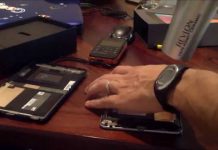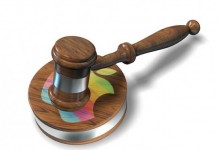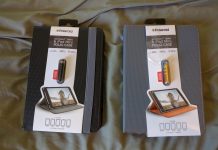 A couple of days ago, someone suggested David write a retrospective about the different e-reading devices he had used through the years. It seemed like a marvelous idea to me, and there certainly is room for more than one such article.
A couple of days ago, someone suggested David write a retrospective about the different e-reading devices he had used through the years. It seemed like a marvelous idea to me, and there certainly is room for more than one such article.
So here is mine.
1. Palm IIIe
I had long wanted a Palm Pilot, ever since reading articles in Salon Magazine and elsewhere about how cool it was to read books on them. Finally, with the 2-megabyte Palm IIIe being particularly cheap, I took the plunge and bought one in August, 1999.
Also in August, 1999, I bought my first e-book:Vernor Vinge’s A Fire Upon the Deep, from Peanut Press—the first of many I would buy from them. At 450K, it took up almost 1/4 of my Palm’s 2-megabyte non-expandable on-board memory, and the display on a 160 x 160 screen was a little…pixelly—but I was happy. I read all sorts of books on that thing.
The main software I used back then—beginning relationships that would last through my next three PDAs—were the Peanut Reader (now known as eReader) and iSilo—with a side order of CSpotRun (for Embiid-encrypted books). I had tried Mobipocket and hadn’t liked it (it wasted too much screen real-estate with ludicrously wide left and right margins). Loading it with content was just a matter of double-clicking the PDB file and hitting the “sync” button. (Ah, those were the days.)
Beyond that, the other apps I used were largely AvantGo for making some favored web content portable, and a little freebie check-register app called MicroMoney that subsequently got bought and turned into the for-pay-only Pocket Quicken. I also used the calendar function to remind me of the upcoming birthdays of all my friends and family. On the whole, I liked the Palm IIIe a lot, and was not at all sorry I had bought it.
But I hadn’t had it very long at all before my eye was turned by another contender.
2. Visor Deluxe
 You know how you buy something one month and something even better comes out the next month? Well, that’s how it was with me. No sooner had I bought my IIIe than Handspring—the company founded by Jeff Hawkins and Donna Dubinsky, the Jobs and Wozniak of the Palm Pilot, after they had been chased out of Palm—released a gorgeous little number called the Visor Deluxe with 8 megabytes of on-board RAM—and an expansion slot. It came out in September, 1999—and I’d bought my IIIe in August.
You know how you buy something one month and something even better comes out the next month? Well, that’s how it was with me. No sooner had I bought my IIIe than Handspring—the company founded by Jeff Hawkins and Donna Dubinsky, the Jobs and Wozniak of the Palm Pilot, after they had been chased out of Palm—released a gorgeous little number called the Visor Deluxe with 8 megabytes of on-board RAM—and an expansion slot. It came out in September, 1999—and I’d bought my IIIe in August.
That 8 megabytes could hold a lot of books—plus, I could buy a 16-megabyte cartridge to plug in the back, and keep about a zillion e-books there too. And the translucent “ice” Deluxe looked so cool, and was nearly as cheap as the IIIe had been, and I had the money—so what could I do but buy one?
The Visor still had the 160×160 Palm screen, of course, but the unit looked so much neater that it seemed to be a better e-book machine. It looked the most like a science fiction prop of any PDA I’ve owned before or since (with the possible exception of my Nokia 770, which I have running a Star Trek “PADD” theme). In fact, it looked a whole lot like the supercomputer control gizmo Al the hologram used in Quantum Leap.
But what was I to do with my IIIe? Well, I had bought a keyboard cradle for it, which accepted a full-sized PS/2 style computer keyboard (which I carried around college with me in my backpack) and let me type into the device’s notepad program. So I took notes on it, while I carted my Visor around with me, too, for e-book reading and such.
So, for a while I was a two-PDA-plus-full-sized-keyboard man. I must have gotten some odd looks going through the hall. It couldn’t last, though. Eventually, when I needed some fast cash, I sold the IIIe and cradle to a college friend, and ended up buying one of those folding keyboards—the kind with full-sized keys that flipped out in four sections?—for the Visor.
Eventually, I broke the Visor’s screen, and it would have cost more to fix it than the device was worth at the time. So I sold it on eBay for parts, sold the keyboard on eBay for cash, and moved on to my next gadget.
3. Sony Clié PEG-T415
 I soon got to missing my Visor once it had gone, and cast about for what sort of PDA to get. After looking at all the various Palm compatible devices available, the combination of price and features in my range led me to settle on the Sony Clié PEG-T415.
I soon got to missing my Visor once it had gone, and cast about for what sort of PDA to get. After looking at all the various Palm compatible devices available, the combination of price and features in my range led me to settle on the Sony Clié PEG-T415.
The T415 had a number of features that appealed to me. It was incredibly thin and light, meaning it would fit more easily in a pocket. It had a scroll wheel I could use to turn book pages. It had double the resolution of the old Palm IIIs and Visors, a 320×320 monochrome screen which would let me read books in that much higher text quality. And, best of all, it came with a universal remote application.
I was still in college at the time, and there were a lot of different dormitories with big-screen TV sets. Some of them expressly forbid people from touching the set. But with a universal remote in my pocket, I figured, I was safe. (This wasn’t always the case, but it was still handy being able to change the channel or adjust the volume without ever having to get up—enough so that, after the Clié stopped working, I actually bought a pocket-sized universal remote to carry with me.)
And it took Memory Sticks, meaning that I was no longer limited to 24 megabytes to hold all my books and other stuff. I shelled out for a 128-megabyte stick, and—heaven!—I could hold as many books as I wanted!
I used that device until I pretty much wore it out; part of the front panel had broken off and the power button no longer worked. I still have the corpse of it at home somewhere, but last time I tried I never could manage to get it to work. Perhaps I should give it to my electronics-crazed brother and see if he can do anything with it. Or maybe I should just buy a replacement: they’re only $25 used on Amazon.
At any rate, the screen is still good. I am willing to entertain offers if anyone wants to buy it for parts.
4. Sony Clié PEG-N760
 After my 415 bit the dust, I didn’t have the money to get another device, nor did I have much desire to buy something that would be incompatible with the Palm stuff I already had. So I made do without one for a while, until I got a job working solo tech support for a small web hosting provider.
After my 415 bit the dust, I didn’t have the money to get another device, nor did I have much desire to buy something that would be incompatible with the Palm stuff I already had. So I made do without one for a while, until I got a job working solo tech support for a small web hosting provider.
My boss had an old Clié PEG-N760 that he’d never even taken out of the box. He decided to pass it on to me, and I immediately took to it. It was the first color PDA I had ever owned, and it kept many of the features I had loved from the 415 (including the memory stick slot, into which I could directly plug the card from my 415).
I never ended up making much use of the built-in media player. At the time, I had my first iPod, and I never really could get movies to work well enough to make it worth loading up with them. But it worked well for books, and other PDAish tasks. Apparently this Clié kept its value better than its predecessors; it is currently going for $97 used on Amazon.
I continued using all the same e-book software as I had before, going all the way back to the IIIe. As with my 415, I used it until it stopped working. It was in pretty rough shape by the time I was done with it; the front panel had entirely come off, and the battery had to be held on with tape. (As with the 415, I still have the corpse at home, and am willing to entertain offers—the screen should still be good.) Then I was again without a PDA for a while.
5. Nokia 770 Internet Tablet
 Last year, one of those deal-of-the-day sites had the Nokia 770 Internet tablet on sale for about $125. I had the money at the time, and thought it would be a cool toy (especially based on some of the reviews of it here), so I bit. My opinion of the device was, in the end, mixed.
Last year, one of those deal-of-the-day sites had the Nokia 770 Internet tablet on sale for about $125. I had the money at the time, and thought it would be a cool toy (especially based on some of the reviews of it here), so I bit. My opinion of the device was, in the end, mixed.
It had a great screen for reading books. 800×400 resolution, full color, with that +/- rocker on the right side in just the right spot for my thumb to page up and down. FBReader did a good job with non-DRM’d Mobipocket books (especially after, only a couple of months ago, I realized I was still using a relatively old and buggy release of FBReader and finally upgraded).
I was also able to use it to listen to music and audiobooks at work—but then the earphone jack blew out after just a few months, and I procrastinated sending it in for repairs until it was out of warranty—thus, its earphone jack does not work to this day.
It was kind of neat to be able to use the full-sized terminal emulator on it to connect to my Linux box and use the terminal session to run TinyFugue. I still use it that way to this very day, even though I now read most e-books on my iPod Touch; it’s got a much better terminal program and the ability to display an entire screen in one go.
The main problems with the device were 1) no support for eReader (though I suspect that might change next year when the Linux client finally comes out) except through emulation, 2) somewhat buggy software (the web browser crashes frequently, for instance), and 3) annoying user interface. To tap out words, it is necessary either to pick them out on a tiny stylus keypad, or use a screen-sized thumb board that prevents you from seeing anything else.
It was also a bit user-unfriendly in terms of how to launch programs and load content. Launching programs required navigating through lots of little menus. And to load books onto it, I had to use a micro-USB cable to mount the internal 2-gig SD card as an external hard drive—which I found didn’t work very well for some reason, so I finally resorted to buying a thumb-drive-style USB SD card reader and popping the card out whenever I wanted to load more content.
Both of these things were cinches for me, but caused it to fail the “grandfather” (or even “father”) test completely. I have my Dad reading Agent of Change on FBReader on it now and enjoying it—but the device stays entirely in FBReader and does not exit, and Dad has to have my help whenever he even accidentally hits the “show frames” button and needs it taken off again. I have no illusions that he could use the 770 as a book reader by himself.
My next device—the iPod Touch—blew the Nokia away on almost all counts.
6. 32 gig iPod Touch (G1)
 I’ll admit, I was skeptical about the utility of the device until I’d had it a while. I bought it mainly because I was tired of being without music on the go, and I wanted to read e-books again. But as I have said in a number of the recent posts I’ve made to this site, I have since been quite impressed.
I’ll admit, I was skeptical about the utility of the device until I’d had it a while. I bought it mainly because I was tired of being without music on the go, and I wanted to read e-books again. But as I have said in a number of the recent posts I’ve made to this site, I have since been quite impressed.
The ‘Touch is incredibly user-friendly. Tap the icon, launch the program—it’s as simple as that. I haven’t tried it on my Dad yet, but I have no doubt he’ll be able to go from launching the program all the way to reading books on it with no problems. And he might even be able to load books into it by himself.
The ‘Touch has a crisp and clear 480×320 screen, which is so sharp and crisp that it can read text at a smaller font size than on the 770—so in a screen-to-screen comparison, it actually shows only about a sentence or two less per screen than the larger 770.
Between the several reading applications available, it handles most formats, including encrypted eReader, and loading is accomplished by wireless from within the program itself. The only format unavailable is encrypted Mobipocket, and there are ways around that for those unfortunate enough to have bought Mobi books.
Most of the software I need to use is completely non-buggy, and even the software that has had a lot of bugs (I’m looking at you, Bookshelf) has seen a huge decrease in them in just the four months I’ve been using my iTouch. Mobile Safari might crash from time to time, but not with anything near the regularity of the 770’s browser crashing, and it always comes right back up again.
And while I was originally skeptical about the thumb keyboard, I have since been converted. The error-correction is the best I’ve yet seen in a non-handwriting-based device. In fact, I frequently use Mobile Safari with Meebo for my instant messaging needs, and can thumb out words nearly as fast as I can type them into a keyboard.
The only thing I wish is that I had just held off for another month. Just as with the IIIe vs. Visor Deluxe, I bought a refurb G1 32-gig in August—and in September, Apple came out with the G2s, and I could have had a new G2 for what I paid for the refurb G1. But on the whole, I’m happy.































I have run through a similar batch of devices, except I started reading eBooks with one of Apple’s Mac laptops and then the Apple Newton. I had three Palms (two had eventually broken screens–a concrete-based work floor is hard on PDA’s!), than two Handsprings (one broken screen, one replaced for a neater gadget), the Clie and now the Bookeen Cybook. I still have the Clie, for encrypted PalmOS books (eReader, TomeReader, etc.).
I’m thinking of a Netbook if Uncle Sam is nice with the tax refund. Can think of an iPhone or a iTouch until the current cellphone and iPod die.
I had/have 5 devices:
Ebookwise 1150 – loved it and read quite a few books on it for the 6 or so months it was my only device, until I saw the 770 in Spring 06. Ebk1150 found a loving home with my father in law and he still loves it.
The 770 was my main device until this November when I saw the PRS 700. I read hundreds of books on the 770 and I would still use it happily, though it’s getting a bit old if not for the 700. I still read on it on the go when I do not bother to pack the 700, since the 770 is pocketable.
In the meantime I got a PRS 500 with the almost free offer with the Sony card (60$ with sh and 50$ back in books) and it was a major disappointment being so slow and clumsy. I read maybe 10 books on it but it found a loving home with a friend.
I also got an iTouch last Christmas (07) and I jail broke it, installed Apache to access its internal drive with Safari and a direct file transferer from my PC and read pdf’s with Safari for a while. Decent at it, though these days I am using mostly for music/movies.
Finally I got the PRS 700 at the beginning in November. As with the 770, I was skeptical until I tried it in store and just fell in love with it. Unbelievably fast for eink, superb pdf handling – I have a 100MB pdf scan and it works like a charm in half page mode – decent sidelights which I got to love, and very good screen, not 505, more like 500 but good enough.
The only drawback is not being pocketable, so I have to pack it in some protective box to take it with me, so for short runs to the supermarket and such, the 770 is still useful since that one just goes alongside my wallet…
The 700 is almost perfect except for the pocketable thingy and I would love color. Do not truly care about wireless but if it comes cheaply, I would not say no…